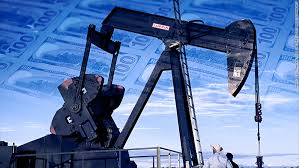Oil ends lower after U.S. crude stockpiles jump, gasoline demand sinks

Oil prices fell on Wednesday after U.S. crude inventories rose last week by the most since 2016, while gasoline demand suffered its biggest weekly drop ever due to the coronavirus pandemic.
Crude inventories USOILC=ECI rose by 13.8 million barrels last week, the U.S. Energy Information Administration said. That was the biggest one-week rise since 2016, and analysts expect similar data in coming weeks, as refineries curb output further and gasoline demand continues to decline.
West Texas Intermediate (WTI) crude CLc1 fell 17 cents to settle at $ 20.31 a barrel, after hitting a low at $ 19.90.
June Brent crude LCOc1 fell $ 1.61 , or 6.1%, to $ 24.74 a barrel. The global benchmark fell to $ 21.65 on Monday, its lowest since 2002, when the now-expired May contract was the front month.
The market has slumped on the sharp fall in demand because of the coronavirus pandemic and rising output from Saudi Arabia and Russia after a supply pact collapsed last month. Brent crude fell 66% in the first three months of 2020, its biggest ever quarterly loss. Saudi Arabia’s production rose to more than 12 million bpd in the most recent months, according to sources.
“The likelihood of distressed cargoes, increased freight rates, force majeures, strains on storage capacity, VLCC availability will be combining in placing additional downside pressures on petroleum prices,” Jim Ritterbusch, president of Ritterbusch and Associates, said in a report.
Russian President Vladimir Putin called on Wednesday for global oil producers and consumers to address “challenging” oil markets while U.S. President Donald Trump complained that oil cheaper “than water” was hurting the industry.
Trump invited several energy industry executives, including the chief executives of Exxon Mobil and Chevron Corp, to a meeting on Friday to discuss aid for the industry, including possible tariffs on oil imports from Saudi Arabia, an administration source confirmed.
News of those efforts has intermittently bolstered futures prices, but physical grades of crude are deteriorating, as refiners and shippers confront the coming wave of supply and freeze-up in demand. Gasoline demand fell by the most ever in one week, with products supplied, a proxy for demand, dropping by 2.2 million barrels per day to 6.7 million bpd. That augurs for more refining cutbacks down the road.
“Demand is a disaster,” said Bob Yawger, director of energy futures at Mizuho in New York. “That’s the whole problem here. It’s horrible.”
The bearish mood has been fueled by a rift within the Organization of the Petroleum Exporting Countries (OPEC). Saudi Arabia and other OPEC members have been unable to agree to a technical meeting in April to discuss sliding prices.
An OPEC-led supply deal fell apart on March 6 when Russia refused to cut output further. Saudi Arabia has already begun to boost output, a Reuters OPEC survey showed on Tuesday, and is expected to pump more in April. [OPEC/O]
“It is very unlikely that OPEC, with or without Russia or the United States, will agree a sufficient volumetric solution to offset oil demand losses,” BNP Paribas analyst Harry Tchilinguirian said in a report on Tuesday.
